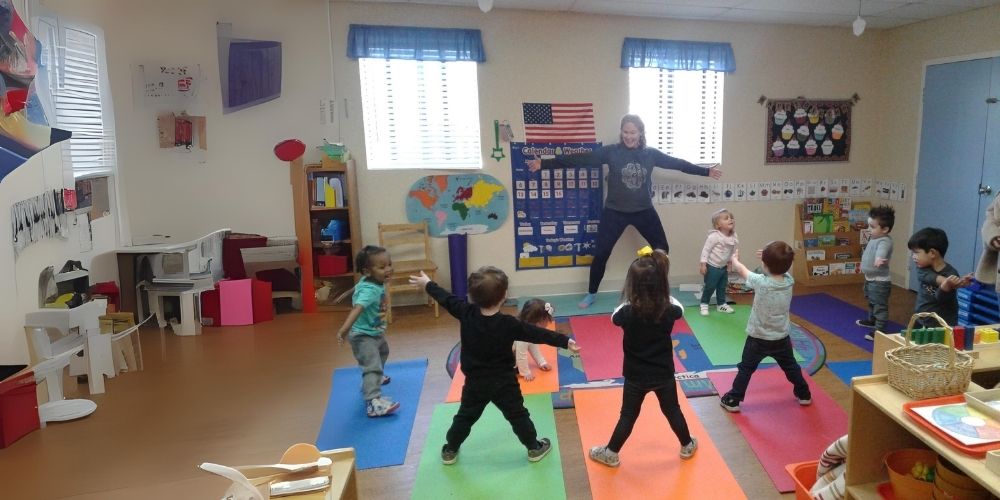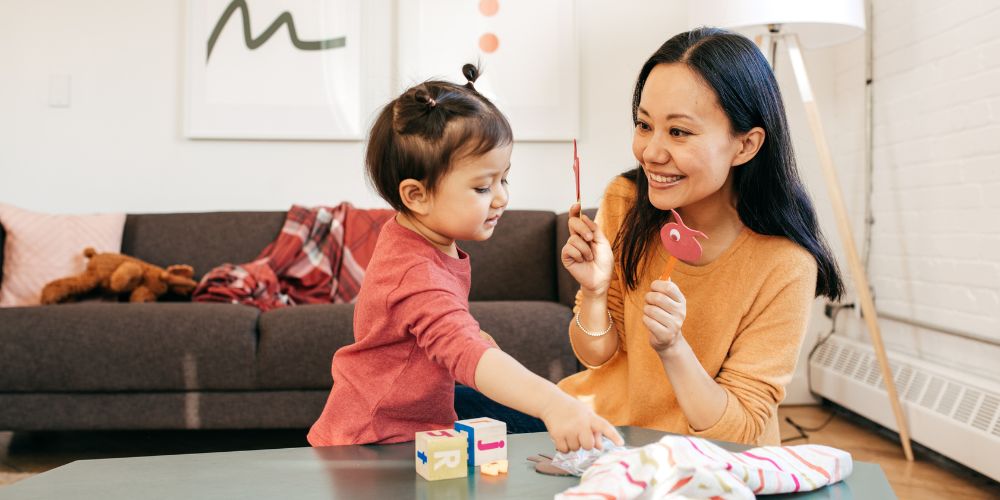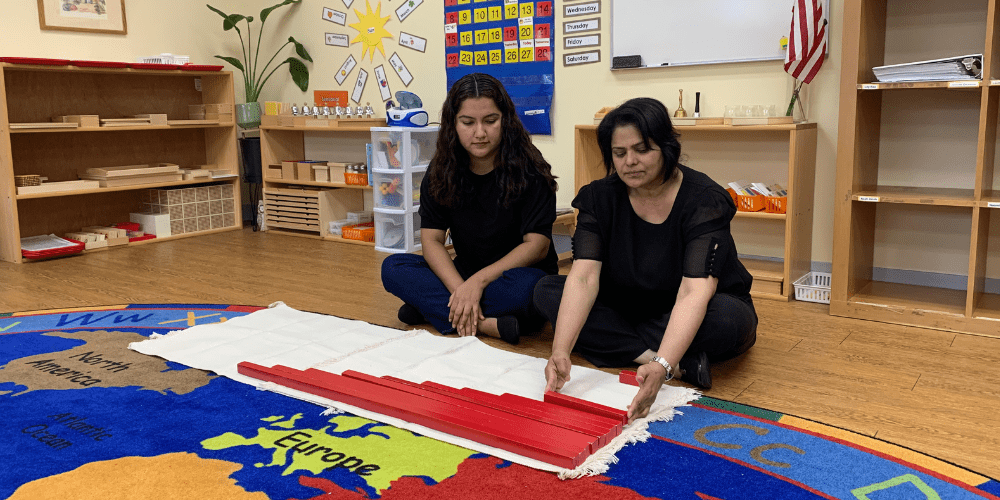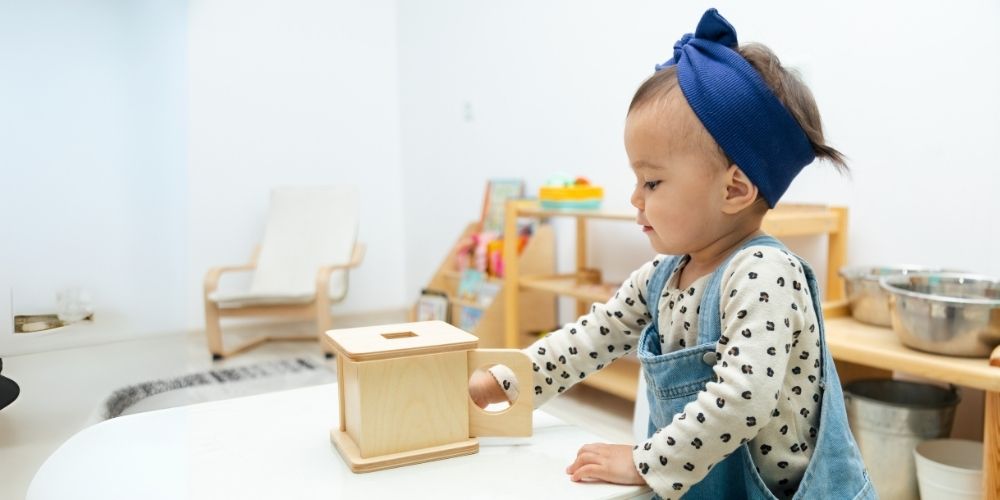As the days get colder and we pile on the layers, getting our little ones ready to leave the house can become a longer and longer process. Fostering independence in a child’s daily routine benefits both parents and children in day-to-day tasks, such as eating breakfast, getting dressed and getting out the door on time. In a Montessori classroom, self-dressing skills are taught in the Practical Life area early on using materials such as dressing frames, which are square wooden frames with various clothing fasteners. Children are able to begin practicing with simple fasteners such as velcro and snaps, then progressing to zipping and buttoning, and finally to advanced tasks such as lacing and bow tying. These skills, taught through repetition, translate to a child’s ability to secure their clothes at home. In addition to the Practical Life lessons taught in the classroom, there are several tips and tricks you can try at home to help your child take ownership of their daily dressing.
The first step in setting your child up for success with getting ready is preparing their environment. Clothing should be easily accessible, either in a wardrobe complementary to their height, baskets on the floor, or a neat stack on a low chair. A low or child size chair will be useful when it is time to put on pants, socks, and shoes. Children should always be presented with options, even if they are limited: the power of choice helps your child take the lead and develop autonomy. When it is time to undress, they should have a designated area to place dirty clothes, such as a basket or hamper. This gives the space order, teaches organization, and highlights personal care by making sure they don’t re-wear dirty clothing.
Not only is it helpful for the environment to be prepared, but the routine surrounding getting dressed should remain consistent. Self-dressing and undressing should be part of the day-to-day rhythm so that children get used to the idea that this is their daily responsibility. This may require setting aside adequate time so the child feels they have the space to make mistakes and self-correct. In multi-children households, this can be a group activity among little ones, so younger siblings can observe and learn from older siblings and use them as a resource when they need assistance. However, rhythms do change over time and sometimes leaving the house on time is a priority. In instances where parents have to step in to speed up the process, they can still keep their children involved by explaining what they are doing and why.
While shorts are an easier option, we are getting into the season where pants are more appropriate for the weather. Children may be insistent in continuing to wear their fun summer clothing, but opening a window or letting them step outside prior to getting ready for the day can help convey the need for warmer layers, so that children make the choice themselves to transition to pants. To simplify the task of pulling feet through pant legs, children should have access to an aforementioned low chair to eliminate balance issues. Teach them to identify markers like patterns or tags to make sure they have the pants oriented correctly while seated, prior to pulling them up. Pants that are roomy, stretchy, and have elastic waistbands are easiest to use. Once this process is mastered, children can move on to jogger-type pants with tighter cuffs or leggings. From there, stiffer pants with buttons and zippers can be introduced.
Shirts can be more difficult and have more room for error when a student is learning to dress themselves. You can start by pulling their shirt over their head halfway and guiding them to the armholes. Once they can get their arms in independently, start guiding them towards the neck hole prior to pulling the shirt on. Once they’ve figured out each step independently, let them try it all together. Again, you can help them to identify tags and patterns to ensure the shirt is on correctly, but give them the space to wear the occasional backwards shirt so they can learn to self correct.
This same step by step method can also be applied to socks. To practice the initial movement of pulling on socks, children can use elastic hair bands. Let them repeat stretching them open to mimic opening the mouth of a sock. From there, they can progress to pulling the bands over their feet and onto their ankles and back off again. Once socks are introduced, they should be extra stretchy, no taller than ankle socks, and may be a size bigger than their feet for practice. You can start by helping them pull them over their toes and let them finish the heel, or let them pull over their toes and help with the heel, depending on which step presents more challenges.
This same simple-to-complex progression can be used when it comes to putting on shoes. Single or double velcro strapped sneakers are great for small children, especially if they have experience with a velcro dressing frame. Sturdy shoes with support are best to ensure the shoe can withstand handling without getting stuck on the heel. Heel tabs or shoe horns can be useful tools to eliminate this issue. While incorrectly orienting leggings or shirts is harmless, it is important that children learn how to correctly put on their left and right shoe to prevent tripping. A few easy hacks are to place different stickers on each shoe (i.e. star sticker for left, heart sticker for right) or to draw half of an image in the inside sole of each shoe. Children can learn how to place the shoes correctly on the floor by recreating the whole image.
Jackets are especially important as we approach winter. Luckily, the famous “Montessori Coat Flip” method turns this potentially time consuming step into a fun trick. To set up this method, lay the jacket out on the floor with the inside facing up. If your child is wearing long sleeves, instruct them to hold on to the ends of the sleeves to avoid them bunching under the jacket. They should stand on the side of the neck or the hood, bend down, and partially put their hands into the sleeves of the jacket. Next, your child needs to stand upright, raise their arms up, and flip the jacket over their head, while allowing their arms to slide all the way into the sleeves. Children will know they’ve made a mistake if their coat ends up upside down.
With a little patience, and these tips as a guide, you can progressively instill the skills your child needs to independently get ready for the day. Through repetition and encouragement, both at home and in the classroom, getting dressed will become a part of your child’s daily routine that they look forward to and feel capable of handling. Most importantly, mastering these personal care tasks will allow students to move through their world with increased ease and confidence.
Want more parenting tips like this? Check our Parent Resources & join us for our monthly Montessori Monday Parent Seminars! Want to explore Montessori Education for your child? Learn more about our Curriculum





